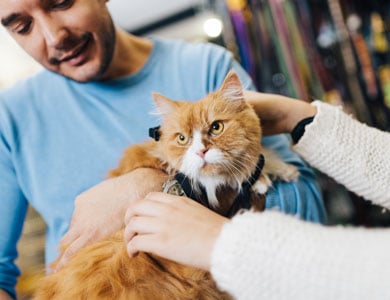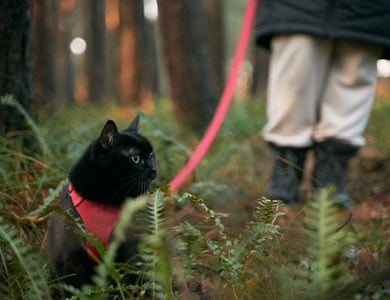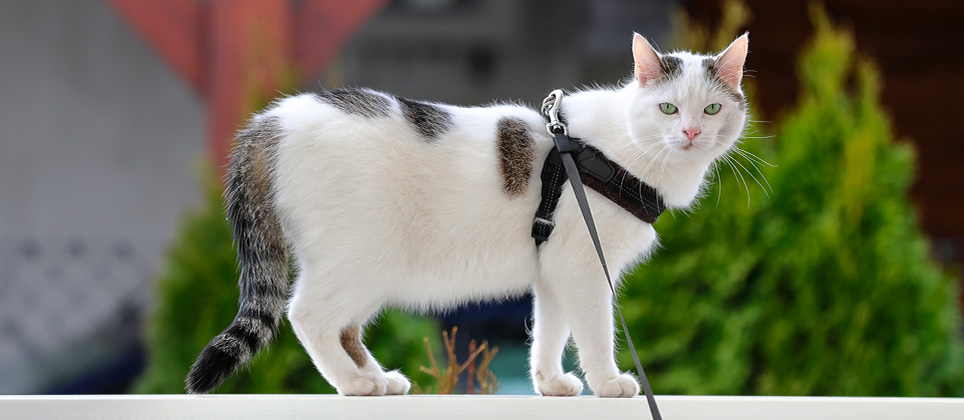Contents
What's been the fastest-growing pet activity of the past five years? Walking your cat on a leash!

This surge in popularity stems from the fact that people, while wanting to protect their cats, also want them to get some exercise. Add to this a situation of confinement and curfews, where one of the only activities allowed was to walk your pet on a leash, and you have an increased interest in leash walking for cats. But is it good for your cat? And if so, how easy is it to get a cat used to walking on a leash?
The answer to the first question is a resounding “yes!”. It’s very good for your cat because it’s an incredible way to keep them active while ensuring they stay safe. An indoor cat’s lifespan is about 11 to 15 years, while the average lifespan of an outdoor cat is 3 to 5 years. Therefore, walking your cat on a leash seems like an ideal compromise.
As for whether it’s easy to walk a cat on a leash, the answer is… sort of. The key? Patience. Here are a few tips to help.
Important: check with your vet to make sure your cat’s vaccines are up to date before going outdoors with them.
Choosing the right harness and leash
To get started, you’ll need to pick the right harness for your cat. As for the leash, avoid using retractable leashes because you must always keep your cat near you.
Features of a good harness
- Make sure the harness is snug around the chest and belly. Don’t use harnesses that have a loop around the neck and stomach but aren’t connected by a strap under the belly. Not only is tugging on the leash uncomfortable for your cat, but it also makes it easier for cats to escape.
- Avoid harnesses that cover the shoulder because most cats hate it when their movements are restricted.
- Use a harness made from mesh fabric and designed to fit around the cat’s torso and under their belly. Once it’s properly adjusted, your cat won’t be able to shake it off.
- Make sure there’s a buckle on the belly and neck. Many harnesses don’t have a neck buckle, meaning you’ll have to slip your cat’s head through a loop. Very few cats enjoy this experience.

How to adjust the harness properly
Cats are incredibly adept at wiggling out of harnesses, especially when frightened – which could occur at any point during their walk. That’s why it’s so important for the harness to be properly adjusted. Not doing so is one of the most common mistakes cat owners make. Each strap should be so snug there’s barely enough room for your pinkie finger to fit through.
Getting your cat used to the harness
We recommend starting in your bathroom. That way, if your cat panics because of the harness, you won’t have to chase them throughout the house. Think of it as a step-by-step process. Another good tip is to get your cat to associate the harness with food and toys.
Grab a feather wand and some treats and proceed gradually. Once your cat is wearing their harness, they’ll most likely freeze or lie on their side. That’s where the feather wand comes in handy. Your cat’s desire to play with the toy should override the impression that they’re stuck in a straitjacket. The more they paw at the toy, the more they’ll realize that the harness doesn’t restrict their movement.
Once your cat is used to the harness, start by walking them inside your home. Then, leave their harness on for progressively longer periods of time.
Also read: The many benefits of playing with your cat every day
Getting your cat used to the outdoors
Cats are extremely attached to their environment and routines. That’s why getting a dog used to walking on a leash is easier. Even if this activity could become part of a cat’s routine, their attachment to their surroundings is more challenging to manage.

A matter of time and desensitization
To help them get used to being outdoors, start progressively and stick to the steps of your plan. And don’t forget to keep treats and a feather wand by your side to help them associate the process with something pleasant. Start with 5-minute sessions. Then, up to 15 or 20 minutes, making sure your cat is calm before you move on to the next step.
- Step onto your balcony or in your backyard.
- Step onto your front lawn to expose your cat to cars.
- Always take the same route and incrementally increase the distance walked.
If you’ve completed these three steps and your cat isn’t showing any signs of stress, repeat the process with your cat on a leash, ensuring everything else remains the same. If your cat has trouble around cars and buses, or if your neighbourhood is busy and noisy, you might want to start out in a park that allows pets. But keep an eye on any dogs around.
Cemeteries that allow pets are ideal places to help a cat get used to being outdoors on a leash. That might seem a bit gloomy, but cemeteries are often quiet spaces with plenty of things to stimulate your cat.
Dangers to watch out for
Walking a cat on a leash requires you to watch them constantly. Here are a few things to keep in mind:
- When you see a dog coming your way, scoop up your cat, hide them, step into a yard, or move to the other side of the street. Even if your cat isn’t afraid of dogs, you don’t know how that dog might react. The last thing you want is for them to start chasing your cat.
- Don’t let your cat rub up against or smell hedges. Another cat or animal may be hiding in them and might jump onto your cat.
- Don’t go out if you’re unsure about the weather, how busy the streets will be, or if your cat doesn’t seem to be in the mood for a walk. That little nagging doubt in your mind that you’ll want to ignore? This time, listen to it because an unpleasant surprise might mean the end of outdoor walks with your cat.

Mistakes to avoid
If something unpleasant does happen during your walk, remain as calm as possible. Act as if everything were normal. Remove your cat from the situation and give them treats to distract them. If they refuse the treats, leave the area or head back home.
The best piece of advice is to take things slow. Some of these steps might take more than a month. While some cats may be at ease walking on a leash within two weeks, others may take two months. The most common mistake cat owners make is to lose patience and push their cat beyond their comfort zone too quickly. When they do, the whole experience will turn into an unpleasant one.
Finally, remember that not all cats are willing to participate in this type of activity. Your cat should enjoy the walk a bit more every time. If that’s not the case, you might be pushing things too fast or not employing the proper technique. Or your cat just might not like walking on a leash. Consult a behavioural specialist if you’re unsure of why.








